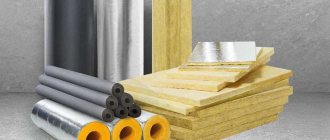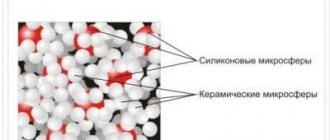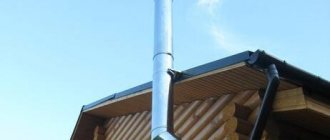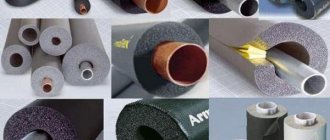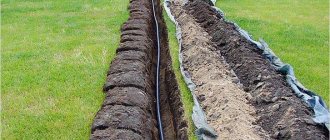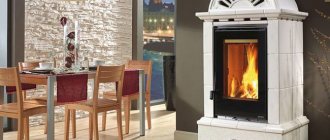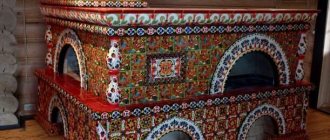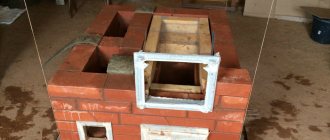The use of thermal insulation materials for stoves has several goals: to ensure fire safety and reduce heat loss . The latter option is most often used in the construction of fireplaces, since in this case it is necessary to create a directed flow of heat, and not to warm up the entire stove mass. When carrying out work, it is recommended to use existing standards to avoid mistakes and prevent the risk of fire in building structures.
Why is thermal insulation needed?
The role of the thermal insulation material is that, due to its poor thermal conductivity, the transfer of energy through the layer of material is difficult. Thus, you can not only preserve the heat that the fireplace produces, but also protect the structural elements of the house from high temperatures.
Chimney insulation serves several purposes.
- At the external location of the pipe, intense heat exchange occurs with the cold air of the street space. A huge part of the amount of heat is released into the atmosphere, but could be used to heat the room. If you reduce this share, you will achieve higher efficiency indicators. The solution to this issue will be insulation, which is applied on top of the walls of the chimney.
- Combustion products that are emitted through the chimney contain carbon dioxide and water vapor. The temperature of all this gas exceeds a hundred degrees. Upon contact with the chimney walls, which have cooled from the external environment, condensation forms on the surface of the latter. Acids, which are a combustion product, are mixed into it. The result is a chemically active environment, leading to the destruction of the walls. The appearance of condensation can only be avoided by increasing the temperature of the pipe itself, that is, by providing it with high-quality insulation.
- In places where the chimney pipe passes through the ceiling or roof, contact of materials necessarily occurs. In the case of wooden buildings, this situation is a fire hazard. But an additional function of insulation will be to protect the ceiling surfaces.
Corner placement option
Internal insulation of fireplaces implies the localization of energy inside the firebox for the purpose of its directed transmission. The fireplace should not emit heat in all directions, especially if it is installed near a wall. It should warm those sitting directly in front of the fireplace. Special reflectors for fireplaces are installed inside the firebox and serve as a screen from infrared radiation. As a result, all the heat escapes through the combustion hole into the room.
Reliable thermal insulation for stoves and fireplaces means protecting the walls of the building from the negative effects of temperature. When the fireplace is located close to the wall, a heat-protective layer is installed, since high temperatures can lead to destruction of the brickwork of the wall or fire if the building is wooden.
Why is insulation necessary?
Chimney insulation prevents the pipe from freezing, especially at sub-zero temperatures. It also prevents:
- Pipe destruction over time. Combustion and decay products negatively affect any, even the most durable and reliable materials. The presence of insulation and the correct structure of the pipe allows you to avoid malfunctions and deterioration of traction;
- Prevents the possibility that the boiler will fail;
- Helps avoid icing. During the use of the stove structure, condensation regularly forms in the chimney, resulting in dampness, which directly affects the condition of the structure.
Important: it is necessary to insulate only that section of the pipe that is completely located on the street or the entire chimney, if the room is not additionally heated.
In order to become more familiar with the proven and best materials and carry out this procedure on your own, we suggest that you familiarize yourself with the photos located in this article.
Advice: when choosing insulation, give preference to the thickest insulation. The thicker their layer is, the better the thermal insulation will be.
General recommendations for insulation
- The selected material should not be thinner than 5 centimeters;
- When winding, it is necessary to leave a small overlap, which is secured at a subsequent stage with a special wire;
- The outer layer usually consists of a special foil or sheet metal;
- The pipe must be reliably protected from above with a special cap and have no cracks.
Important: if moisture gets on the heat-insulating material, it completely loses its non-flammable properties.
The price of insulation directly depends on the type, quantity, quality of the selected material and manufacturer.
Important: it is necessary to take care of the insulation of pipes at the design stage, since later there may not be enough space for it on the outside.
Winding pipes between floors and in the attic
Chimney insulation diagram in size
Requirements for thermal insulation materials
At its core, a fireplace is the same stove with an open firebox and chimney, equipped with decorations. These products do not have any other design features, therefore the approach to their installation and equipment is the same. Thermal insulation, accordingly, is carried out separately for the firebox and for the chimney and must meet the following requirements:
- Low thermal conductivity
- Environmental friendliness
- High fire resistance
- Durability
- Maximum permissible heating temperature
The materials must retain the listed properties in full throughout their entire service life.
The main task of thermal insulation of fireplaces and stoves
The most important aspect in the operation of fireplaces and stoves https://vek-pechi.ru/catalog/pechi-dlya-doma-chugunnye/ is fire safety. This is exactly the case when the desire to save money or simple negligence together with ignorance can lead to big trouble. The main structural element responsible for safety is high-temperature thermal insulation.
Theoretically, you can do the installation yourself, but since we are talking about human lives, it is better to entrust this work to specialists. There are many companies on the construction services market that are capable of performing such a service efficiently, but the choice of contractor should also be approached with the utmost rigor - the company must have been on the market for a long time and have an excellent reputation. You shouldn’t involve migrant workers and coven workers; there will be no one to ask.
Overview of the thermal insulation materials market
The following will provide comparative characteristics of the materials available for free sale.
Rockwool Firebats
Due to its attractive price and high availability, it is the most popular product in the field of application in question. Composition: 100% stone (gabbro-basalt) wool. Available in two types: uncoated and with aluminum foil on one side. The maximum permissible temperature on the foil side is +500°C, on the cotton side +750°C. Slab size 1000*600*30 mm, density 100 kg/m3.
The thermal conductivity coefficient at +300°C is 0.088 W/m*K. The option without foil is not flammable, with foil the flammability class is G1. When choosing this material, it is very important to calculate the peak temperature of the firebox, since overheating may cause the foil to peel off and an unpleasant odor to spread throughout the room along with microparticles of cotton wool fibers. Insulator slabs are highly flexible and therefore are mounted in a rigid metal frame.
Vermiculite
A natural mineral from the hydromica group, the layered structure of which forms multi-colored threads when heated. Fire retardant materials are produced from it by pressing. In addition to fireboxes, it is used in the aviation and automotive industries, as well as in nuclear energy as a reflector and absorber of gamma radiation. The material is presented in two products on the market:
- VermixFireproof. Country of origin - Russia, thermal conductivity coefficient at +300°C - 0.18 W/m*K, plate size 600*600*30 mm, density 300 kg/m3, permissible temperature +800°C. Among the advantages are ease of processing and installation; a rigid frame is not required. There are also disadvantages - the material is afraid of moisture.
- Skamolex is a vermiculite thermal insulator imported from Denmark. It is a symbiosis of refractory and decorative panels with various design solutions. Thermal conductivity at +200°C is 0.16 W/m*K, plate size 1000*610*25 mm, density 600 kg/m3, peak temperature +1100°C. Advantages: does not require subsequent finishing treatment - according to the “set it and forget it” principle, used for lining fireboxes. The downside is the high cost; depending on the region of the Russian Federation, the price of a slab can be 5 times higher than a slab of the same area Vermix Ogneupor.
Based on calcium silicate
The next series of thermal insulators is calcium silicate - an inorganic substance in the form of a calcium salt and metasilicon acid. The mineral is presented on the market in the following versions:
- Silca 250km. Imported from Germany. Slabs measuring 1000*625*40 are designed for use in stoves, fireplaces and brick chimneys. Density 250 kg/m3, thermal conductivity coefficient 0.09 W/m*K at +200°C, application temperature +1100°C. The structure of the board is not fibrous, it can act as both an insulator and a facing material, and is absolutely harmless to human health. The installation features do not include a metal frame. Suitable for thermal insulation of wooden walls in places where the firebox is installed.
- Promasil 950 ks is another product from Germany with a size of 1000*500*30 mm and a density of 245 kg/m3. Peak load is 900°C, thermal conductivity at +200°C is 0.10 W/m*K, which is insignificantly inferior to the previous insulator at half the cost. It is easy to install without a frame, the manufacturer guarantees environmental safety. The material is relatively new, there are very few practical reviews on its use, and construction specialists are confused by the low price compared to analogues.
- Scamotec 225 - sample from Denmark. Slab size 1000*610*30 mm, thermal conductivity coefficient 0.08 at +200°C, maximum application temperature +1000°C, easy to install without a frame, harmless to health, combines thermal insulation and decorative qualities, it can be coated with any fire-resistant paint. The cost is in the middle price segment.
- Isolrath 1000. Country of origin: Austria. Size 1000*610*30 mm, density 240 kg/m3, thermal conductivity 0.06 W/m*K at +200°C. Operating temperature up to +900°C, a frame for installation is also not needed. The manufacturer guarantees environmental and fire safety against the backdrop of high structural strength. It also belongs to the middle price segment.
High-temperature thermal insulation up to 1000-1260°C (slabs): comparison of thermal conductivity
A comparative table of thermal conductivity of high-temperature thermal insulation (thermal insulation boards) from various manufacturers with a maximum application temperature of 1000...1260°C is presented.
High-temperature thermal insulation is made from aluminosilicate raw materials based on Al2O3 and SiO2 (the same raw materials are used in the production of ceramics). A variety of methods can be used to create pores, such as processes based on burnout, foam, expansion or outgassing. In addition, evaporating liquids or solids may be used, fibrous structures and natural or artificial aggregates may be used.
Thermal insulation boards are mainly characterized by low density and thermal conductivity. Their thermal conductivity depends not only on the density and overall porosity of the material, but also on the size and shape of the pores, the type of structure and mineralogical composition of the thermal insulation.
The thermal conductivity of thermal insulation boards decreases linearly with decreasing pore size. Microporous high-temperature insulation boards (for example Promalight-1200 and Promalight-1000X) with pores less than 0.1 microns have the lowest thermal conductivity.
As the pores become larger, the thermal conductivity of the slabs increases: at a temperature of 540°C by approximately 10%, and at 1100°C by 14%. The large-porous structure reduces the thermal insulation properties of high-temperature thermal insulation, especially at temperatures above 900°C due to increased heat transfer by radiation inside the material. To obtain high thermal insulation characteristics, the maximum pore diameter in the material should be no more than 1 mm.
According to the table, it can be seen that microporous Promat boards (Promalight-1200 and Promalight-1000X), Alison Aerogel Panel GY10, as well as boards based on ceramic fibers Avantex Board-1260 have the lowest thermal conductivity at high temperatures. The traditional mullite-silica board MKRP-340 is characterized by relatively low thermal insulation characteristics. Comparison of thermal conductivity of high temperature insulation boards
| Thermal insulation grade | Appearance | tmax, °С | t, °С | λ, W/(m deg) |
| Avantex Board-1260 | 1260 | 400 600 1000 | 0,06 0,15 0,19 | |
| Zircar ceramics MAG-30 | 1260 | 400 800 1100 | 0,11 0,17 0,26 | |
| Promalight-1200 | 1200 | 200 400 600 800 | 0,029 0,033 0,039 0,044 | |
| Plate MKRP-340 | 1150 | 600 | 0,23 | |
| Promasil-1100 Super | 1050 | 200 400 600 800 | 0,075 0,084 0,101 0,125 | |
| Promalight-1000X | 1000 | 200 400 600 800 | 0,023 0,026 0,030 0,036 | |
| Alison Aerogel Panel GY10 | 1000 | 200 500 800 1000 | 0,023 0,033 0,065 0,12 |
- Avantex company website (Russia).
- Chirkin V.S. Thermophysical properties of nuclear technology materials. 1967 - 474 p.
- Website of the company Zircar ceramics (USA).
- GOST 23619-79. Fireproof heat-insulating mullite-silica fiberglass materials and products.
- Promat company website.
- Website of Alison Aerogel (China).
What material is used
All building materials that provide insulation and are suitable for use in a fireplace can be divided into separate groups. These include stone fibers and silica, superisol, mineralite, gypsum fiber, supersil and vermiculite.
- Stone fibers are obtained by pressing crumbs of gabbrodolerite and limestone. The resulting fibrous structure is formed into plates. One side of the plate is covered with foil, which is capable of reflecting radiation, because this type of heat propagation accounts for about half of the total energy. Such foil can withstand temperatures of several thousand degrees. This material is quite durable and moisture resistant. Able to provide all possible assistance in maintaining the integrity of the structure in the event of a fire. The most popular fiber brands: PAROC FPS 17, TECHNO T80, Rockwool.
Rockwool brand insulation
- The technology for using silica involves melting alumina and quartz sand. The resulting glassy mass is blown into fiber form. Fiber is already a heat-insulating material, but for ease of use it is produced in the form of slabs or rolls. This substance is flexible, which makes it easy to insulate surfaces that are not perfectly flat.
- Products based on calcium silicate have good thermal insulation properties. Superizol is one of the representatives of this class. Its porous structure not only improves technical performance, but also facilitates easy processing. Super-insulated slabs are used to insulate fireplace casings and chimneys. They are mounted with glue or self-tapping screws. The operating temperature of the material should not exceed 1200 °C degrees.
- Vermiculite slabs represent a pressed grain structure of the substance. This is a fairly rigid structure, thanks to which the surface of the slab is ready for decoration. They have a relatively high density, but are easy to saw and process. Characterized by their durability. Buyers are showing increased interest in the Thermax, GRENAR-ISOL and Scamol brands.
Panels made of fire-resistant material Superizol
Thermal insulation not only improves the efficiency of the fireplace, but also provides fire protection. It is important that the material remains safe for humans when heated. The requirements for building insulating materials are technical performance, environmental friendliness and ease of processing.
- Supersil is a flexible material. It comes in the form of a silica fabric with a foil-like layer. But such production is expensive in terms of cost, which affects the final price of fabric rolls.
- Gypsum fiber sheets are produced by mixing cellulose with gypsum and then pressing them. A distinctive feature of such sheets is that they can be used as a building material. Gypsum fiber does not tolerate deformation, therefore it is used only for insulating the fireplace body, walls and floor.
Thermal insulation of sauna stoves
The stoves in the baths deserve special attention. Felt is used as the most popular material for insulating sauna stoves - it is a cheap but effective material: it does not burn, but smolders, emitting a characteristic odor, which often becomes a signal of a fire.
The use of thermal insulation materials for furnaces has several purposes: to ensure fire safety and reduce heat loss
. The latter option is most often used in the construction of fireplaces, since in this case it is necessary to create a directed flow of heat, and not to warm up the entire stove mass. When carrying out work, it is recommended to use existing standards to avoid mistakes and prevent the risk of fire in building structures.
Special thermal insulation for fireplaces is used to minimize heat loss in all parts of the fireplace: the chimney, the stove mass and the firebox itself. This allows you to increase the efficiency of heating equipment. Insulation of different parts of the fireplace has the following goals:
Protects the chimney from the destructive effects of condensation that forms during a sudden change in temperature. The aggressive effect of condensate is due to the moisture content, various acids formed during combustion and carbon dioxide. Where the pipe passes through the ceiling, special care should be taken to comply with fire safety standards
If wooden building materials are used, special care should be taken when protecting the ceiling surface. High-temperature insulation in fireplaces is used to create a directed flow of thermal energy to warm people sitting across from it. For these purposes, infrared reflectors are used, which are installed in the firebox itself. Protection of wall structures using a heat-protective layer. Otherwise, a brick wall can quickly become unusable due to a sharp temperature change, and a wooden wall can catch fire.
Otherwise, a brick wall can quickly become unusable due to a sharp temperature change, and a wooden wall can catch fire.
The building materials used for thermal insulation of the fireplace are represented by the following groups:
- containing stone fibers (Rockwool, TEXHO T80, PAROC FPS 17) – are produced in the form of slabs and have a foil coating on one of their sides, which allows them to withstand temperatures of several thousand degrees;
- based on silica obtained from quartz sand and alumina, produced in the form of flexible plates;
- Superizol - is made using calcium silicate and has good thermal insulation qualities, suitable for insulating fireplace bodies and their chimneys, attached with glue or self-tapping screws;
- Vermiculite – presented in the form of slabs (Scamol, Thermax), consists of compressed grains of the substance, is rigid, easy to saw, and has a surface suitable for finishing;
- Supersil - is a fabric made of silica with a layer of foil, has a high cost;
- gypsum fiber - obtained by mixing and pressing gypsum and cellulose, suitable only for insulating solid fireplaces, floors and walls, does not withstand loads and is deformed.
When choosing materials, it is important to make sure that they are environmentally safe so that they do not release toxic substances into the environment when heated
Carrying out work
The technology for thermal insulation of a fireplace consists of a step-by-step solution to certain problems.
Setting tasks and solving them
- The required amount of material is calculated. For more efficient use, take into account the cutting and processing ability of the insulation boards or fabric.
- If the fireplace is located at a distance not exceeding 50 cm from the wall, then sheets of insulating fiber are attached to its walls.
- The degree of insulation can be increased using a multilayer structure.
- The chimney is insulated, regardless of what material it is made of.
The characteristics of modern insulating materials will help answer the question, how to properly insulate a fireplace? To insulate walls, it is advisable to use slabs, one side of which is covered with foil. The foil creates a protective screen, and the effectiveness of such protection is quite high. A negative quality is the unaesthetic appearance of slabs made of insulating material.
In wooden buildings, it is recommended to use several layers of insulation. To do this, a lathing is made of metal slats into which gypsum fiber boards are inserted. A wooden sheathing is mounted on top to secure sheets of fire-resistant plasterboard. The outside surface must be finished with tiles or artificial stone.
Several technologies are used to perform chimney thermal insulation. One of them is making a sandwich pipe. A box is made of metal, which has a larger diameter compared to the diameter of the chimney pipe. Mineral wool is laid along the walls of the box. Then a pipe of smaller diameter is inserted inside. When manufacturing the structure, it is necessary to provide for the option of wrapping the pipe in parts.
The brick pipe is insulated with plaster, which is applied in several layers on all sides. After the fourth layer, the outside of the pipe is lined with mineral wool slabs. They are fastened with self-tapping screws with large washers. The outside must be made of brick; it will give an aesthetic appearance to the pipe and protect the material from precipitation.
Classification by composition
High temperature insulating materials are divided into the following types:
- Packed and filled: zirconium oxide, quartz sand, various mortars, kaolin. Used mainly in industry, labor-intensive to manufacture
- Fiber insulators: fire-resistant wool, felt, felt, are essentially mineral wool and its derivatives. They have the lowest thermal conductivity coefficient, are resistant to thermal shock, but can be susceptible to mechanical damage
- Solid materials: fire-resistant cardboard, fireclay bricks, fire-resistant ceramic slabs. Retains original shape and can bear mechanical loads
In everyday life, the fireboxes of stoves and fireplaces, as well as metal and asbestos-cement chimneys, are insulated mainly with mineral wool. Brick chimneys are insulated with solid materials with cladding, or simply plastered in three layers.
How to do it yourself?
- First, the required number of thermal insulation boards is taken, which are cut to the size of the fireplace insert.
- After this, a special heat-resistant glue (mineral, cement-based) is applied, and the application should be carried out pointwise.
- When installing foil material, glue is applied to the non-foil part.
- After this, the slabs are mounted on the walls. Joints and other openings must be sealed with special heat-resistant aluminum tape, which can also be reinforced.
Oxygen index
The oxygen index is a fire safety characteristic of a material, which shows the minimum amount of oxygen per unit volume of insulation. According to the oxygen index, there are several flammability thresholds:
- 40% - composite polymers;
- 31% - fibrous and cellular non-flammable insulation;
- 20% - materials that burn well in air.
Fireproof wall coverings
To prevent spontaneous combustion of the walls adjacent to the furnaces, it is necessary to install special cladding made of non-combustible materials with thermal insulation properties.
Thermal insulation for furnaces in this case is carried out in two ways:
- For cladding, materials are used that have reflective properties and are resistant to high temperatures.
- The heat-insulating furnace casing is covered with a lining of heat-resistant tiles.
Good reflective qualities are shown by metal sheets covering non-flammable heat-insulating sheets. It is best to use stainless steel, since galvanized steel releases toxic substances when heated.
It is recommended to polish the outer surface of metal sheets, as this helps to better reflect thermal energy.
The following materials are used as thermal insulation:
- basalt cardboard;
- basalt wool;
- minerite;
- asbestos cardboard.
In accordance with SNiP 41-01-2003, installation of the casing is carried out in the following sequence:
- Installation of insulation with a ventilation gap of 2 to 3 cm. The thickness of the insulating material is no more than 2 cm and no less than 1 cm.
- Installation of metal sheet.
- Maintain a distance between the stove and the casing of at least 38 cm.
Ceramic bushings are used to attach materials to the wall: they allow the required gap to be maintained and are resistant to fire. If it is not possible to maintain the specified distance between the stove and the casing, then two layers of thermal insulation sheets should be used. For example, two sheets of mineralite are attached using ceramic bushings. The distance between them is 2-3 cm. The outer sheet is covered with stainless steel.
The design of a room or bathhouse does not always allow the installation of metal cladding. Often it will not fit into the interior of the room. In this case, you can resort to sheathing with heat-resistant tiles, which are attached using a special adhesive that is resistant to high temperatures. We list the suitable materials for cladding:
- terracotta tiles;
- porcelain stoneware;
- tiles;
- clinker tiles;
- Soapstone chlorite
When installing, follow the following rules:
- The ventilation gap between the wall and the fireproof sheet should be 2-3 cm.
- Fire-resistant tiles are attached to the installed sheet using special adhesive mixtures.
- The oven should be located no closer than 15 cm from the surface of the tile.
The following are suitable sheet fire-resistant materials for cladding with cladding:
- minerite;
- fireproof plasterboard containing fiberglass;
- glass-magnesium sheet.
The cladding will help not only to complement the design of the room and maintain a unified style, but also to reduce the permissible distance between the stove and the wall.
How to insulate brick pipes
If you don’t know how to insulate a brick chimney, we suggest using one of the following options:
- Application of plaster. This option is one of the simplest, fastest, most effective and affordable. The plaster must be applied to a pre-installed reinforcing mesh. In total, it is necessary to apply from 2 to 5 layers depending on the thickness of the bricks. The total thickness of the plaster should be more than 50 millimeters. After the solution has completely dried, it must be thoroughly rubbed and 1-2 layers of chalk or lime paint applied to the surface;
- Mineral wool:
- A sheathing made of a metal profile is fixed to the inside of the pipe;
- Each guide must be securely secured with dowels;
- Insulation can be purchased both in rolls and in tiles. The first option is the most convenient;
- Basalt wool must be secured between the gratings. In this case, it is necessary to completely eliminate the occurrence of gaps;
- The next layer is to lay a vapor barrier;
- A plaster mesh is fixed, onto which several layers of plaster are applied, which must contain cement.
Thus, you can use one of the most convenient and suitable ways to insulate a brick chimney.
Chimney installation and insulation with non-combustible materials
Winding and insulation of the chimney
Advice: using mineral wool is the most expensive option. Installation using this scheme takes longer than standard plastering.
Protective screens for furnaces
The thermal insulation material used for stoves must not only prevent the possibility of fire, but also protect people from too harsh infrared radiation. Protective screens for fireplaces, as well as for sauna stoves, are ideally suited for these purposes. They can be made of metal or using brick or decorative stone.
The peculiarity of fireplace screens is that they are made exclusively of metal and can be built-in or mobile. Such designs prevent sparks and hot coals from entering the room, and also, when heated, contribute to the rapid and uniform heating of the air in the room. You can purchase a protective fence or make it yourself. Let's take a closer look at the features of furnace protective screens.
Brick protective screen
Along with insulation, the furnace is insulated using bricks. There are two options: constructing a protective wall and lining the furnace with bricks. In both cases, the brick is laid using an adhesive mixture or clay. The use of cement mortar is considered as a last resort. When lining the stove with brick, it is necessary to provide a gap of 3 to 10 cm, as well as ventilation holes at the bottom and top to ensure better convection and quick heating of the room.
What to do if the gap behind the stove is minimal
There are times when the wall and the stove are very close to each other. Then there can be no talk of thick protective screens. In this situation, the following technologies can be used:
- strengthening the partition by hanging metal screens;
- placement of slabs made of ceramic material;
- replacing all existing gaps with mineral wool;
- winding the chimney using a street reflector (the material is heat-resistant foil).
On a note! Remember that mineral wool does not react well to condensation. The insulating layer accumulates moisture, ceases to fulfill its tasks and deteriorates over time.
Stainless steel casing
Thermal insulation of the furnace using stainless steel casing has several options. Based on orientation in space, front and side screens . The recommended distance from the oven to the screen is from 1 to 5 cm . Thanks to such structures, it is possible to reduce the intensity of thermal radiation from a metal furnace, since the outer surface of the protective screens warms up to 1000 C. In this case, it is possible to reduce the distance from the furnace to the wall to half a meter. Ease of installation and the presence of special legs that allow you to securely fasten the screens make their use especially attractive.
Winding of stove and fireplace metal pipes
Before insulating the external chimney, it is necessary to select the most suitable material and calculate its exact quantity.
Winding instructions and materials:
- The simplest option is to use a special solution. Special powders are used as a mixture, which must be diluted in a certain proportion with water;
- You can buy the mixture at any specialized hardware store;
- First, a special glass fiber stack must be attached to the surface of the pipe, which will prevent the solution from rolling and spreading.
Important: if you don’t know how to insulate the chimney pipe from the attic side, use mineral wool panels.
For finishing walls under a boiler
If the walls of the boiler room are wooden, then they need to be pre-treated with fire retardants. The wall behind the boiler must be covered with sheet metal . The remaining area is finished with sheets of plasterboard or glass-magnesium. Then the surface is plastered or covered with ceramic tiles.
Right choice
The choice is based on the scope of application of the insulation. Thus, basalt wool is relevant for insulating roofs, walls, ceilings and facades, as fire protection for ventilation and building structures, pipelines, baths and saunas. Foam glass is an excellent non-flammable insulation for chimneys; it is appropriate to use it for insulating roofs, walls, ceilings and fire-resistant structures.
If you want to insulate an apartment with foam glass, then you need an L-shaped bracket, an anchor, which will help secure a layer of blocks to the plastered wall (ceiling). Fiberglass is applicable for insulating attics, roofs, walls, floors along joists, partitions and interfloor ceilings, saunas and baths, walls behind radiators of central heating systems.
Basalt with cladding
Basalt facing slabs look aesthetically pleasing and provide good fire protection. In addition, this material gives off heat for a long time after heating. You can use this material to cover both a brick screen and the wall itself on top of insulating sheets.
Fire safety cannot be treated negligently - the consequences of carelessness can be tragic. The modern building materials market allows you to choose an option according to your means and taste, while providing reliable protection against fire.
Cellular types
Cellular non-combustible materials resemble frozen foam in structure. This type of insulation can withstand high temperatures.
Foam glass
Inorganic insulation with a cellular structure similar to soap foam. The base is crushed glass, which is mixed with carbohydrate. Foam glass has the following positive characteristics:
- environmentally friendly, durable;
- resistant to fire and temperatures;
- does not absorb moisture and does not allow steam to pass through;
- not susceptible to acids, bacteria, fungi, does not attract rodents.
Foam glass can be used in almost any industry - construction, chemical, energy, engineering industries. The only drawback is the high price.
Foam glass has a significant drawback - its heavy weight, which complicates installation.
This material is especially recommended for insulating basement walls.
PPU
Polyurethane foam, as a non-flammable material, has a serious list of qualities:
- when exposed to open fire, it does not emit harmful substances;
- low moisture absorption coefficient (1.5%);
- not afraid of temperature changes and mechanical stress;
- does an excellent job of sealing and thermal protection.
This convenient and easy-to-install material is used to insulate saunas, baths and other objects.
Tips from the pros
In order to increase the fire safety of the ceiling that crosses the chimney or chimney, install a decompression chamber by installing a heat-insulating board in a horizontal position.
It is preferable to provide 2 fan grilles in the box : one for the purpose of cooling the decompression chamber, and through the other, warm air will be transmitted throughout the room. Sheets of plasterboard are attached to the iron guides using self-tapping screws: they will be the basis for the decorative finishing of the fireplace.
How to insulate a chimney
Having protected the walls from the hot fireplace insert, proceed to insulating the pipe. For this, one of the following materials is used:
Chimney insulation
- mineral wool is the most popular and sought-after material, which is convenient and inexpensive to work with;
- glass wool - its properties are similar to mineral wool, but it is more difficult to work with;
- brick - the use of whole and chipped specimens is allowed;
- slag slabs - designed for insulation in unstable climatic zones.
If the fireplace and chimney are made of brick, then insulation is carried out quickly and with little financial loss. To do this, the surface is plastered using a reinforcing mesh. At the junction of the pipe and the roof, reinforce it - lay an additional layer of brick. This completes the thermal insulation.
It is much more difficult to work with round pipes made of metal and ceramics. These materials overheat strongly during operation of the fireplace, and accidental touching them will inevitably lead to severe burns. Therefore, be sure to take care of insulating such pipes. This is necessary to reduce heat loss and maintain the integrity of the pipe for a long time.
Thermal insulation is carried out with non-flammable materials of dense structure. Mineral wool is ideal and is used to wrap the pipe as the first layer. The second layer of insulation is reinforced on top - stainless steel sheets. They are wrapped around the chimney and sealed. Instead of stainless steel, plaster can be used.
The above method of thermal insulation increases the efficiency of the chimney, increases the service life of the structure and prevents overheating of nearby surfaces. If all the work is done correctly, then re-installation will be required after about 15 years with intensive use of the fireplace.
The best and proven insulation materials
If you don’t know how to insulate a chimney, we suggest you familiarize yourself with the main materials and the features of their use.
- Choose a material that can withstand not only the effects of high temperatures - up to 300 degrees, but also their sudden changes;
- The best option would be special fiber-based insulation;
- Also perfectly suitable are glass wool, mineral wool, slag concrete slabs;
- Additionally, when carrying out this procedure, it is necessary to use a fixing mixture - plaster;
- For sandwich pipes, you can opt for sleeves made of stainless steel.
Important: before purchasing materials, make sure that the insulation does not make the pipes very heavy. This can negatively affect the condition of the roof over time.
Non-flammable winding for sealing the chimney
Mineral wool for pipe insulation
Insulation for chimneys can be cylindrical. This variety is sold together with special foil. This allows you to quickly and efficiently perform insulation.
Tip: when choosing a finished product, pay attention to its thickness. The material should not cover the entire interior of the chimney or most of it. This will not allow the draft to work at full capacity (How to make a draft amplifier with your own hands), and combustion products will accumulate inside or remain in the room, which is very dangerous to health.
How to insulate a chimney - scheme of work and manipulations:
Heat resistant sealants
This type of sealing materials is produced on a silicate basis, which makes them stable at temperatures close to 1300-1500 °C. Some of them can even withstand temperatures of 1600 °C for a certain time.
In this case, they are dark gray or black in color and are called fire-resistant pipe sealants (the word “fire-resistant” is on the outside of the tube or package).
Some important rules when using heat-resistant sealants:
- Work with silicate sealing materials is carried out in the temperature range of +5 - +40 °C.
- The required sealing effect is achieved only in the case of rough and uneven surfaces. For this purpose, if necessary, the areas where the composition is applied are treated with abrasive materials.
- In addition, the surfaces should be degreased with acetone and then allowed to dry for 15-20 minutes.
- When the paste hardens in places where the sealant is applied, very strong and hard seams are obtained, so it is not recommended to use heat-resistant compounds for structures operating in vibration conditions.
- Traces of sealing material can be removed with a wet cloth or rag, but only before the material hardens. After hardening, this will require the use of mechanical force and some simple tools.
The main advantages of insulation
Insulation for chimney pipes has the following advantages:
The walls are reliably protected from condensation on the surface, which does not allow moisture to accumulate. All combustion products come out along with smoke.
As a result of thermal insulation, hot air and cooled walls do not create sudden changes.
Insulated pipes retain and retain heat for a long time, which makes it possible to profitably save consumer resources.
The structure becomes more durable and reliable. The likelihood of various destruction and damage caused by environmental influences is eliminated.
Important: insulated pipes tolerate frost well and retain all their characteristics and original appearance for a long time.
You can learn how to properly carry out insulation by watching the video in this article.
